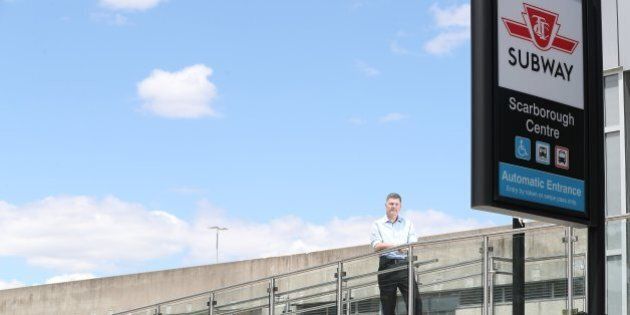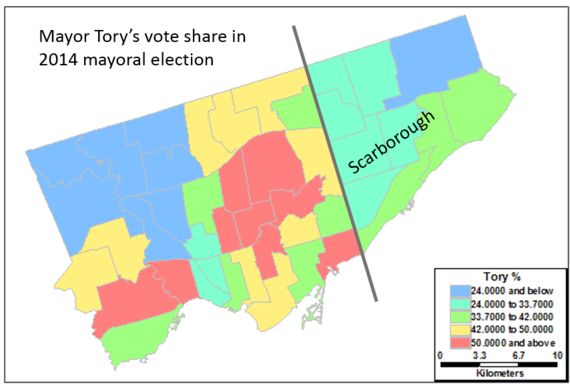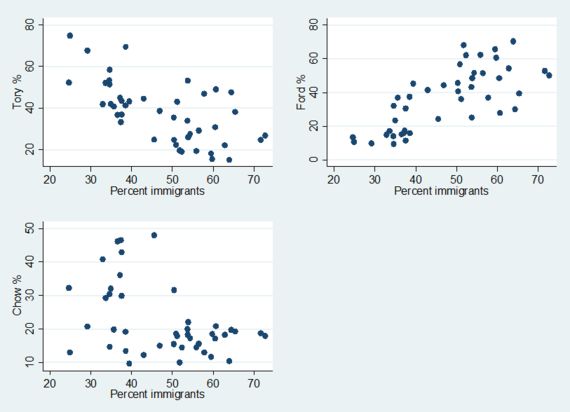
When politics trumps engineering, everyone loses.
Toronto's mayor, John Tory, is pushing the Scarborough subway extension despite the opposition by transport engineers and planners, and increasingly, members of the public. Mr. Tory is caught between a rock and a hard place. If he does not support the subway extension, he might appear indifferent, even vindictive, to the voters in Scarborough who overwhelmingly voted against him in the last mayoral election. Some political pundits believe that one has to hitch a ride on the Scarborough subway to victory in the next mayoral election.

Data Source: City of Toronto. Map drawn by (c) Murtaza Haider, 2014.
The political divide in the last mayoral election already had a transport angle to it. Given the spatially polarized electorate, the support for the three leading candidates was roughly correlated with commute times. For instance, Mr. Tory's vote share was lower in the wards with longer commutes. The reverse was true for other candidates, especially Mr. Doug Ford. Furthermore, Mr. Tory struggled in the wards with larger immigrant cohorts where Mr. Ford's support was much stronger.

Data Source: Statistics Canada and the City of Toronto. Graph drawn by (c) Murtaza Haider, 2014.
In an op-ed in the Toronto Star, Mr. Tory articulated his reasons for supporting the subway plans. He wrote: "The process has been flawed and it's a decision I have struggled with, but the current plan to extend the subway east is in the city's best interest." Mr. Tory is correct about the flawed process, but he is wrong on what transit strategy is in the city's best interest.
From a transport planning perspective, the one-stop Scarborough subway extension is highly unlikely to make Scarborough residents' lives simpler by offering them fast and efficient mobility. Instead, it could make their transit commutes even longer and more cumbersome.
Mr. Tory refers to the analysis prepared by Jennifer Keesmaat, city's chief planner, who believes "multiple stops along the way" are "unnecessary." This is a profoundly erroneous conclusion that is in conflict with the fundamentals of transportation engineering and is likely a result of bounded rationality. Refusing to acknowledge that the forecasted growth in the transit ridership along the corridor will be insufficient to support high-capacity subway leads to such illogical conclusions.
Given the lack of demand during off-peak hours, Mr. Tory's Scarborough subway will run near empty for most of the operating hours, requiring one of the highest operating subsidy per trip in the TTC system. These subsidy losses will be in perpetuity and in addition to the wasteful $3-billion plus in capital costs.
A one-stop subway that runs in a tunnel for miles and does not allow transit riders to switch from buses is highly unlikely to increase the transit ridership in Scarborough. Networked transit does not equate buried transit with no linkages. Putting mobility needs of a few who could afford to live or work within a walking distance of the Scarborough Town Centre ahead of the commuting needs of the majority of the suburban population is poor transport and political planning.
An LRT operating with multiple stops provides the possibility of densifying development along the corridor, and especially around transit nodes. At the very least, multiple stops will allow commuters to switch to and from buses in a networked transport system. Richard Soberman, former Director of the Metropolitan Toronto Transportation Plan, does warn, however, that improved accessibility by transit "does not always guarantee either land use intensification or increased employment density."
While it is true that 73 percent of those who start their trip at the Scarborough Town Centre are headed downtown, the numbers are minuscule: fewer than 3,000 riders during the morning peak period. The highly optimistic forecasts of 7,300 peak-hour passengers in 2031 rely on equally inflated real estate development projections, which Professor Soberman points out, have not materialized in the past in Toronto's suburbs.
As the mayor, Mr. Tory should enable public forums for informed debate where members of the community and transport experts can have a dialogue about how best to meet the current and future needs of the city. A sincere, informed, and open public dialogue is necessary to avoid tunnel vision on public transit.
Follow HuffPost Canada Blogs on Facebook